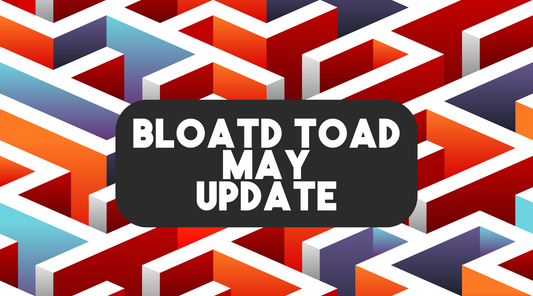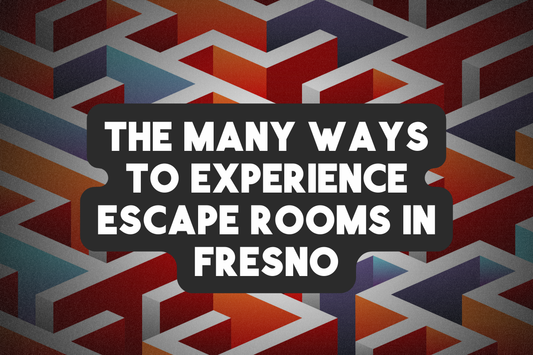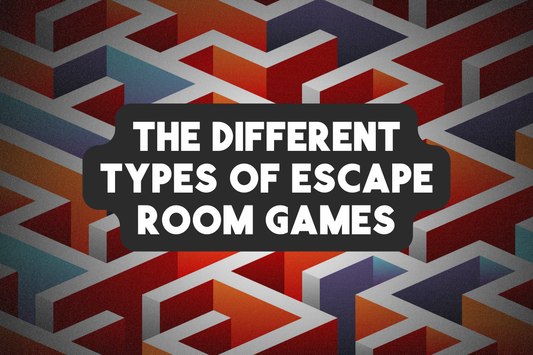The Set Design of Cerebral | Part 2
Calvin KammerShare
Last week we talked about the top three rules we place when we build an escape room set, and it offers some critical context for why we make the rooms the way we do. We recommended checking out that article before reading on, but there is no way for us to enforce that so I guess just do what makes you happy?
Once we had the story determined, and an approximate idea of the kind of setting we are looking for, we look for inspiration. We review different sets that stood out to us, either in a movie, theme park, haunted house, or even other escape rooms. While we draw inspiration from these sources, we make it a point to never copy but to always make it our own.
For those that are familiar with the final door in King’s Keep, you will remember how the door lit up spectacularly.

The initial inspiration behind the door is the legendary door to Moria (the Doors of Durin for you LOTR nerds) from Fellowship of the Ring.
I was always drawn into the scenes outside of the mine (and they call it a mine. A MINE.) where the party of adventurers have to ponder the riddle of the door. (As a side note if you know the answer then you also know the password to my Wi-Fi.) I think this is the best example to demonstrate how we as a team use inspiration, not to imitate or copy what we’ve seen, but to explore new ideas with the concepts that others have established.
What’s the inspiration for Cerebral?
First and foremost SAW. This one was really a no-brainer for us. This is the franchise that kicked off many people’s love of horror and would have a surprisingly high overlap in this arbitrary venn-diagram I made.

So starting off we knew we were looking for an abandoned industrial look. Thinking of rusty pipes, water damage, and an overall unpleasant place to be. So Grandma’s House was out of the question, but there were plenty other location ideas that we kicked around from a meat-packing plant to a morgue. We played with many of those ideas until settling on one: a serial killer’s basement.
We could have lots of freedom for how we dress the set, unlike a place like a meat-packing facility. Adorn the walls with the decorations that our killer would like, and we could make it as clean or dingy as we like!
What does our serial killer’s basement look like?
This would point us in the right direction for what would be in the room. Old, run-down, and honestly gross looking furniture, with smoke-stained walls and black mold. Lot’s of black mold. Off to a great start.

From the floors, to the ceiling!
We like to consider every aspect of the space we are working in. Playing a wild-west saloon and having office carpet under your feet just doesn’t make sense to us! We wanted a gross floor, without it actually being dirty. (I’m sure there are geniuses out there that just realized that simply not cleaning it would give it the most authentic look possible with literally 0% effort, but we are not gross people.) Instead of carpet or other types of flooring, we decided to put our efforts into the raw, torn-up concrete already in the room. It took a good amount of effort in removing the floor glue and grinding the space down but it came out looking like an old concrete basement! With a coat of watered-down brown paint we were able to give it a slightly more uniform look (it was very distracting how random the floor looked) and then followed with a sealer giving us our finished look!

My favorite part of the floor (which is probably an odd sentiment to have about floors) is how uneven it is. We were meticulous in how we cleaned the floor to allow certain areas and sections of the floor to be slightly lower than others, not to the point where players may potentially trip, but enough to make them uneasy. The differences are so slight that unless you know before playing you probably wouldn’t notice it. But just because player’s won’t be able to appreciate it at face value it does add to the experience that we are aiming for. Our goal isn’t to have the floors draw attention to them but rather just be one more small detail that makes the experience complete.
The ceiling was a project itself, regrettably we have some pretty ugly ceilings. The building we are leasing is quite old, and we have to work extra hard to overcome our old, ugly building’s shortcomings. If it sounds like I am being hard on an inanimate object which has given us the opportunity to make the rooms we love, you would be correct. This building sucks.

Luckily it is super easy to hide the ugly behind black paint. While I personally haven't been to a home with a black ceiling, we’ve found that most people can look past it, this is after all only a game! With a darker ceiling the eye naturally ignores it while playing so it never really comes up. We also effectively “lowered” the ceiling by dropping the black by a foot. Because of this, it simulates a better sense of depth, making the room feel less “room-ie” and more of an immersive set.
Why is there a 32” TV in my medieval dungeon?!
The industry norm at this point is to include a monitor in the room which acts as both a way to track time and deliver clues. While there isn’t anything wrong with this approach, it’s one that we don’t care for in terms of set design. After all, why would there be a TV in a dusty candle-lit dungeon?
For our rooms we instead prefer to do things the hard way and offer more unique solutions for time tracking and clue delivery. For King’s Keep we had a set of 12 candles mounted up high (higher than 8 feet, RIP the deer trophy you will be missed but not forgotten). Every 5 minutes a candle would flicker out and die, 5 candles remaining means you have 25 minutes left! We were able to go in plenty of different directions but we wanted this timer to be thematic, so we cobbled together the various displays we are using to build up an oversized segmented display. It’s so powerful it almost drowns the room in an oppressive red glow!
Clues for this one were more straightforward than our previous spectral phone line or helpful cellmate prisoner. We opted for an intercom system with an integrated push to talk button which we have found to be essential for non-intercom literate players. Most escape rooms I’ve seen are fine with sending over essentially a text message to inform players their clues, but it detracts a certain level of immersion from the experience. By having the clue system be infused with the storyline it allows for a greater level of immersion without compromising the players' need for help once in a while!
To find out how exactly we were able to weave together an oversized segmented timer and intercom system with the story you will have to play the game!
Lights, CCTV, Action!
With the set determined, next we discussed lighting. For the vast majority of rooms i’ve played the escape room’s lighting is usually the lighting that came with the lease: fluorescent lighting. You know the kind; long tube, ugly tint, sometimes noisy. This type of lighting is perfect for offices and schools, but this game is set in a basement and would need different treatment. For example, we had to create and install medieval sconces for lighting in our King’s Keep room, the fluorescent tubes wouldn’t be enough for what we wanted! Imagine booking a room that’s set in a medieval dungeon miles below the castle, just for it to have modern lights drowning everything in the room in the same dull light.
Dynamic lighting is something that we consider almost every time we start the design process of an escape room. Wouldn’t it be cool if you fail at an Operation-type puzzle only for the room to be engulfed in red alarm signals and a bellowing siren announces your presence? Well, we think so, but we have not been able to replicate what we want without a ton of extra work. There is an upcoming project where we plan to fully explore this idea of dynamic lighting in our rooms.
So if we aren’t using the lights that came with the building, and we aren’t using dynamic lighting yet, what exactly are we planning to do?
In the 2009 zombie-shooter Left 4 Dead, the level designers decided to use lighting to highlight points of interest to the players. Since the majority of the post-apocalyptic FPS takes place at night, the designers would strategically place sources of light for the players to flock to, not unlike moths. If there are three abandoned buildings but one has a porch light on, that’s the one players will instinctively go to without much forethought. It is so ingrained in people to gravitate towards light that we use the same strategies as the video game designers. If it ain’t broke don’t fix it!
We have a collection of eccentric lamps spread throughout the room. A trained eye (or someone that read this dev log) would see that wherever the light is cast is an important step in the game. Just follow the lights!
The lighting design is similar to that of our previous haunted cabin escape room, Clancey's Lodge. We had a similar situation with this room, what kind of lighting would a cabin have? Our first thoughts are some classy deer trophy chandeliers, but thankfully we never ended up going that direction!
Escape Room players understandably believe that everything may be a clue. Anything that is out of place or emphasized may be helpful but what separates escape room first-timers and ER veterans is the ability to reason out whether something is intentional or not. For example, when the room first launched we had an ornate deer-skull trophy mounted 8 feet above the ground. Before entering the room we always inform players that anything high up can be ignored, especially the deer trophy on the wall right over there. Within a week the skull was in a million pieces on the floor.
If we had a chandelier I doubt it would have lasted as long as the trophy! So we had to go a slightly different approach with dimmed and creepy overhanging lights you would typically see in places like a basement. If it worked in the cabin it would probably be just as good in our basement. Time will tell if we decide to add additional lighting beyond the overhead lights and highlight sources like desk lamps or standing lamps.
A quick side note is the use of CCTV’s systems to monitor the rooms. We always like to hide the camera’s using black paint. Nothing worse than being in a haunted cabin and thinking that you are supposed to think you are being watched!
Escape games that have more than one room offer an unexpected level of depth that many players crave. The revelation that there is a whole second space full of puzzles and problems to solve is exhilarating for enthusiasts, and probably a little disheartening for struggling escape novices.
Without giving anything away, we wanted the killer’s hidden sanctum to be messed up. Expect screams, viscera, and body horror. The first half of this room is all about building up anticipation, only for it to pay off in a huge way for the second half.
As an added bonus we were able to better incorporate the second room in a way I have never seen before, which reinforces the point that set design can often aid the game design process. Most of my favorites parts of our rooms aren’t the puzzles themselves, but the revelations of the secrets the set had hidden.
The hidden sanctum is a favorite for us. We always love including a second hidden room if possible. The reaction to revealing a whole new room is always priceless. I give my thanks to Scooby Doo, because everyone has seen it, and who doesn’t love a hidden room?
Thanks for reading in on the many facets of thought that go into a single escape room’s set!
We will talk more about the unique game mechanics you will be utilizing during your Cerebral experience on our next dev log, The Game Design of Cerebral.
(One last note for those that read the previous dev log about our 3 rules for set design, I finally got my concrete bunker!)







